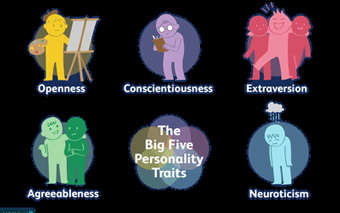Understanding the Five Big Personality Traits
Understanding the Five Big Personality Traits
 Personality is an essential trait that makes up the characteristics of a person, without which a person will cease to exist. Some say that people may be associated with their surroundings that influence their general characteristics.
Personality is an essential trait that makes up the characteristics of a person, without which a person will cease to exist. Some say that people may be associated with their surroundings that influence their general characteristics.Key features of the Five-Big Personality Traits
-
The Five Big Personality Traits are- experience, conscientiousness, extraversion, agreeableness, and neuroticism.
-
Each personality trait represents a continuum and individuals can fall anywhere in between that scale of the traits.
-
Studies say that the personality of a person can remain constant through childhood into adulthood. However minor changes can appear in the personality trait.
The Five-Big Personality Traits
Each of the traits represent a continuum, for example, the trait of extraversion is introversion. Together, introversion and extraversion make up the two opposite ends of the spectrum of the Five-Big Personality Trait. People could fall on either extreme ends of the spectrum or could fall in between as well.
-
Openness to Experience
 If one possesses the high openness to experience, he/she is open to all the original and complex things life has to offer both experientially and mentally. The opposite trait of openness is close-mindedness. Individuals who closely resemble this trait are curious, imaginative, artistic, interested in several things, excited and unconventional in their ways.
If one possesses the high openness to experience, he/she is open to all the original and complex things life has to offer both experientially and mentally. The opposite trait of openness is close-mindedness. Individuals who closely resemble this trait are curious, imaginative, artistic, interested in several things, excited and unconventional in their ways.-
Conscientiousness
Conscientiousness means to have a good impulse control which enables individuals to fulfill the tasks and meet goals. Conscientiousness includes proper planning and organisation, delaying gratification, avoiding impulsive action and following cultural norms. The opposite of conscientiousness means to lack direction. Some of the key components of conscientiousness include competence, organisational skills, lack of carelessness, achievement through hard work, self-discipline and self-control.
-
Extraversion
Extraverted individuals draw energy based on their interactions with the outside world. Extraverts are sociable, talkative and outgoing. The opposite of extraversion is introversion. Extraverts are gregarious, assertive, active, excitement seeking, emotionally-positive, warm and outgoing in nature.
-
Agreeableness
 The trait of agreeableness refers to a positive and altruistic orientation. This trait enables individuals to see the best in others, trust and behave pro-socially. The opposite of agreeableness is antagonism. Agreeable people are often trusting, straightforward, altruistic, modest and sympathetic.
The trait of agreeableness refers to a positive and altruistic orientation. This trait enables individuals to see the best in others, trust and behave pro-socially. The opposite of agreeableness is antagonism. Agreeable people are often trusting, straightforward, altruistic, modest and sympathetic.-
Neuroticism
Neuroticism refers to a tendency towards negative emotions and includes experiences like feeling anxious and depressed. The  opposite of neuroticism is emotional stability. The key factors of neuroticism include anxiety and tension, hostility and irritability, depression, shyness, moody and lack of self-confidence.
opposite of neuroticism is emotional stability. The key factors of neuroticism include anxiety and tension, hostility and irritability, depression, shyness, moody and lack of self-confidence.
 opposite of neuroticism is emotional stability. The key factors of neuroticism include anxiety and tension, hostility and irritability, depression, shyness, moody and lack of self-confidence.
opposite of neuroticism is emotional stability. The key factors of neuroticism include anxiety and tension, hostility and irritability, depression, shyness, moody and lack of self-confidence. Can personality be changed?
Personality traits tend to remain highly stable during adulthood. Though a person might experience gradual shifts in some of the traits, a complete shift cannot drastically occur. For example, a person who is highly extraverted might experience certain shifts in his/her personality but will still remain extroverted.
Certain studies state that this consistency maybe explained through genetics, which plays a significant role in the development of traits in a person. Another observation also noted that the environment may indirectly reinforce inherited traits. For instance, in creating an environment that works with their own traits, parents may also create an environment that works with their children’s traits. Similarly, as adults, people tend to choose environments that reinforce and support their traits.





















